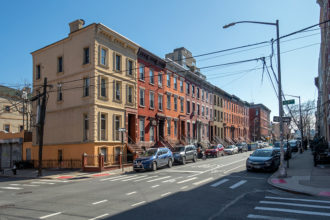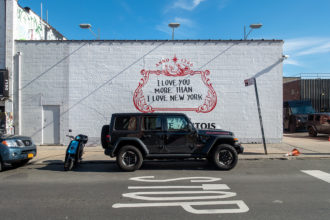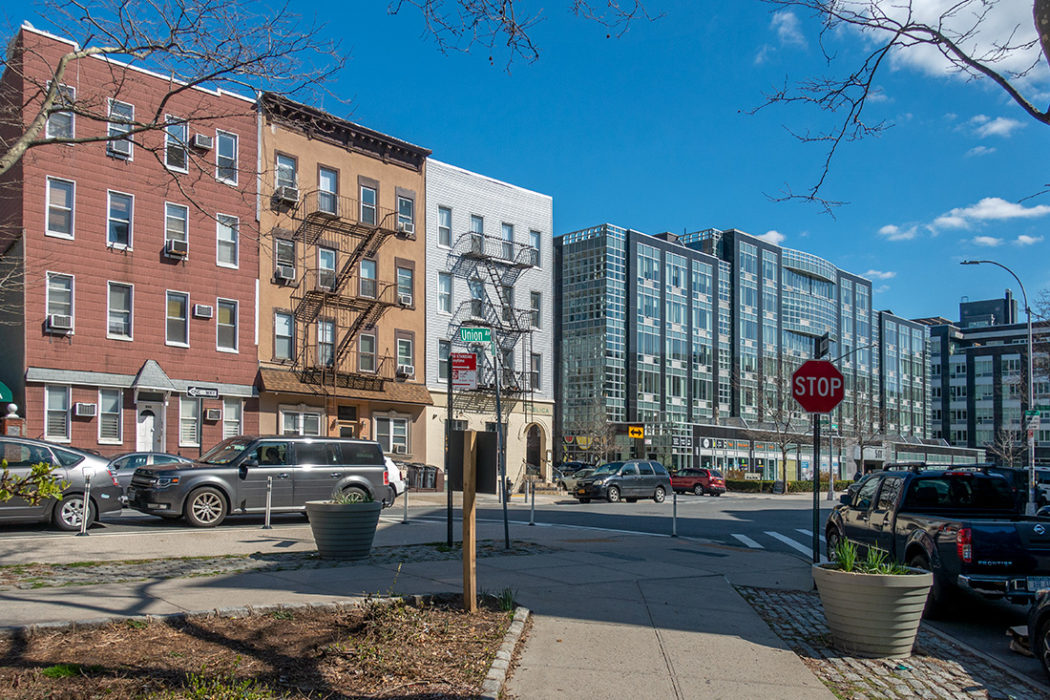As a photographer, the concept of sheltering in place is foreign to my instincts, but here in New York, in the midst of this invisible infectious storm, we have been ordered to stay at home. However, we are permitted the liberty of taking walks as long as we maintain the requisite social distance of six feet (2 meters). So I’ve been walking the streets and parks of Williamsburg, Brooklyn, largely devoid of human presence, a stage set without actors, and no audience, still brightly lit. It is a troubling, but strangely beautiful moment in the history of this dynamic city, the daily ebb and flow of commuters from the suburbs frozen, and the countless flights from abroad grounded. We are alone in the world together – all nine million of us.
 Having done this work a long time – documenting the urban landscape – I understand the value of taking a patient measure of change and continuity in contrast to the more episodic nature of photojournalism. In 1980 I photographed the Lower East Side at a time when New York was crumbling, and many had given up on the city. In retrospect, it turned out to be a moment of rebirth more than a moment of decline. My photographs serve as a record of that inflection point in history.
Having done this work a long time – documenting the urban landscape – I understand the value of taking a patient measure of change and continuity in contrast to the more episodic nature of photojournalism. In 1980 I photographed the Lower East Side at a time when New York was crumbling, and many had given up on the city. In retrospect, it turned out to be a moment of rebirth more than a moment of decline. My photographs serve as a record of that inflection point in history.
A few years later, I photographed the Iron Curtain and the Berlin Wall. I did not know when I started that project that the wall would soon open, that democracy would sweep across eastern Europe, and that my work would constitute a key document of that time.
Before 9/11, I made many photographs of lower Manhattan that included the World Trade Center, the Twin Towers as ubiquitous signposts on the skyline. After their destruction, I continued to photograph the site, collecting visual evidence, following the gradual rebuilding of the city. I had no special access. No commission. I just did what I do as a photographer.

The greatest lesson for me, as obvious as it may be, is to never take anything for granted. Even the most seemingly permanent of structures – physical, political, cultural – can disappear in the blink of an eye. The present is quite likely another pivotal moment in history. It will test our resilience as urban animals, human beings, living in a complex, dense environment. It will test our institutions and possibly our democracy.
The pictures I am taking are not dramatic depictions of the calamity that has befallen New York. They are simply what I see walking the streets in this “time of plague”. The trees are blooming, and the sky is blue, adding insult to injury. Or perhaps, signalling hope that we will come through this stronger, as we have come through great upheavals in the past.

Photographer Brian Rose studied urban design at the University of Virginia and moved to New York City in 1977 to attend Cooper Union. In 1980, he and fellow Cooper graduate Edward Fausty photographed the Lower East Side of Manhattan. In 1985 Rose began photographing the Iron Curtain and the Berlin Wall, resulting in the book ‘The Lost Border. The Landscape of the Iron Curtain’ (Princeton Architectural Press, 2004).
 From 1993 to 2007, Rose lived in Amsterdam. In 1998 he photographed the Mercatorplein neighborhood with its immigrant population and Amsterdam School architecture: ‘Mercatorplein, Image of a World in Amsterdam’. Back in New York in the mid-2000s, Rose began re-photographing the Lower East Side of New York. ‘Time and Space on the Lower East Side’ (2010) was followed by two companion books: ‘Metamorphosis’, about the Meatpacking District, and ‘WTC’, a chronicle of the Twin Towers and the rebuilding of the World Trade Center.
From 1993 to 2007, Rose lived in Amsterdam. In 1998 he photographed the Mercatorplein neighborhood with its immigrant population and Amsterdam School architecture: ‘Mercatorplein, Image of a World in Amsterdam’. Back in New York in the mid-2000s, Rose began re-photographing the Lower East Side of New York. ‘Time and Space on the Lower East Side’ (2010) was followed by two companion books: ‘Metamorphosis’, about the Meatpacking District, and ‘WTC’, a chronicle of the Twin Towers and the rebuilding of the World Trade Center.
His most recent project was about Atlantic City (Circa Press, 2019). In a series of urban landscape images, Rose portrays Atlantic City as a metaphor for America’s dysfunctional politics. The John Adams Institute devoted a blog series to this project. Rose’s images have been collected by the Museum of Modern Art and the Metropolitan Museum of Art. All images © Brian Rose